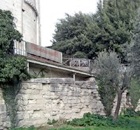

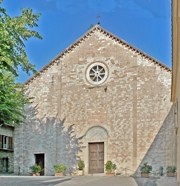
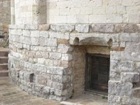
The earliest surviving document in the cathedral archives dates to January 963, in the episcopacy of Bishop Eremedius. It relates to the lease of some episcopal property, the rent of which was to be paid each year of the feast of Santa Maria Assunta, which suggests that Santa Maria Maggiore was the episcopal church at this time. It was also known as Santa Maria Maggiore in order to distinguish it from Santa Maria Minore (later Santa Maria delle Rose).
The subsequent surviving documents in the archives indicate that the bishops of Assisi at Santa Maria Maggiore were at the heart of the civic life of Assisi in the 10th century, assisted by a phalanx of auxiliary clerics. The earliest surviving references to a the presence of canons in Assisi date to 1029, when they were associated with both Santa Maria Maggiore and San Rufino (see below).
Santa Maria Maggiore remained the cathedral of Assisi until ca. 1035, when San Rufino assumed this function and the bishops’ residence was moved to the site of the present Palazzo dei Canonici della Cattedrale. Nevertheless, the church remained important, particularly after ca. 1082, when the bishop’s residence was re-established to the right of it, in the site of the present Palazzo Vescovile.
The church was largely rebuilt during the late 12th century:
-
✴An inscription on the rose window (see below) apparently records that Iohannes (perhaps Giovanni da Gubbio) built the facade in 1162.
-
✴Another inscription in the apse (on the left, at the top of the steps) records that this part of the church was built in 1216, at the time of Bishop Guido I and St Francis. This is the oldest known inscription that ears the name of St Francis.
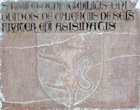
The church was badly damaged in the earthquake of 1832, when the ceiling of the nave and its right aisle were destroyed, along with many of its frescoes and its stained glass.
Garden
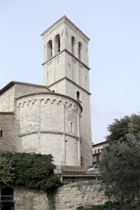
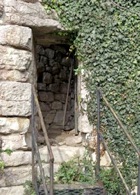
"Iter precar(ium)"
This seems to indicate that passage was granted by prayer or on request. The inscription is obscured by ivy, but there is a plaster cast of it in the Museo Civico (Exhibit 125).
Facade


Interior
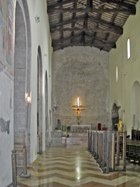
The nave, which has a trussed roof, is separated from the vaulted aisles by walls, each of which has three arched openings. Steps at the end of the nave lead up to the presbytery and the semicircular apse, and down to the crypt (see below). An interesting relief (8th century?) with braided decoration that is now embedded in the wall beside the stairs.
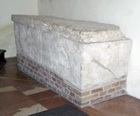
Altare di San Giuseppe
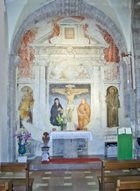
-
✴St Joseph holding the Virgin's wedding ring (on the left); and
-
✴St Francis (on the right).
Traces of the larger fresco under the plaster were discovered some 20 years ago, but it was only after the earthquake of 1997 that the full work was recovered. The restoration work revealed an older fresco (ca. 1560) of the Crucifixion with the Virgin and St John the Evangelist at the centre of the composition, which has been attributed to Dono Doni. It was probably been over-restored in 1640, when the fictive altar surrounding it was executed.
The work as it now appears is composed within a large fictive frame: two kneeling angels in the lunette above flank the IHS monogram.
Madonna della Misercordia with saints (late 14th century)
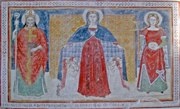
This fresco, which is on the left wall of the nave, between the first two arches, is attributed to the Maestro di San Leonardo:
-
✴The Madonna protects male and female penitents under her cloak.
-
✴St Blaise (to the left) holds the wool comber with which he was martyred).
-
✴St Lucy (to the right) appears after her defenestration, holding her eyes on a plate.
The inscription below gives the date MCCCLXXX, indicating that the fresco post-dates 1380. It is likely that Confraternita dei Disciplinati di Santa Maria Maggiore, which was also known as the Confraternita di San Biagio (St Blaise) commissioned it.
SS Onuphrius (late 14th century) and Stephen (1476)
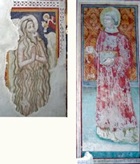
-
✴St Onuphrius (Onofrio, Humphrey) is depicted as a hermit, visited by an angel who brings him food.
-
✴St Stephen (above) is depicted as a deacon. This fresco is dated by Inscription.
Pietà (late 15th century)
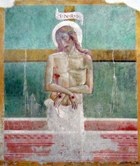
St Blaise (14th century)
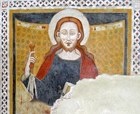
Madonna and Child (mid 14th century)

St Antony Abbot (14th century)
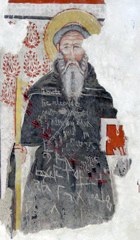
Annunciation (mid 14th century)
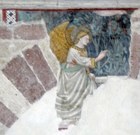
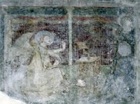
Capture of Christ (14th century)

Crypt
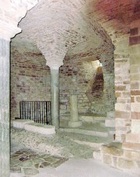
The crypt leads to the excavated Roman domus known as the House of Propertius.
